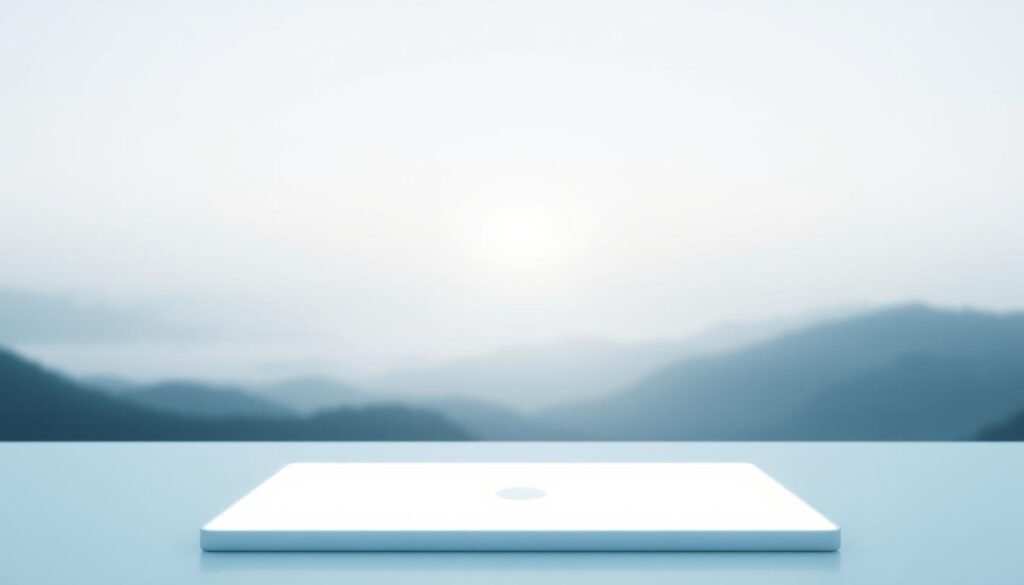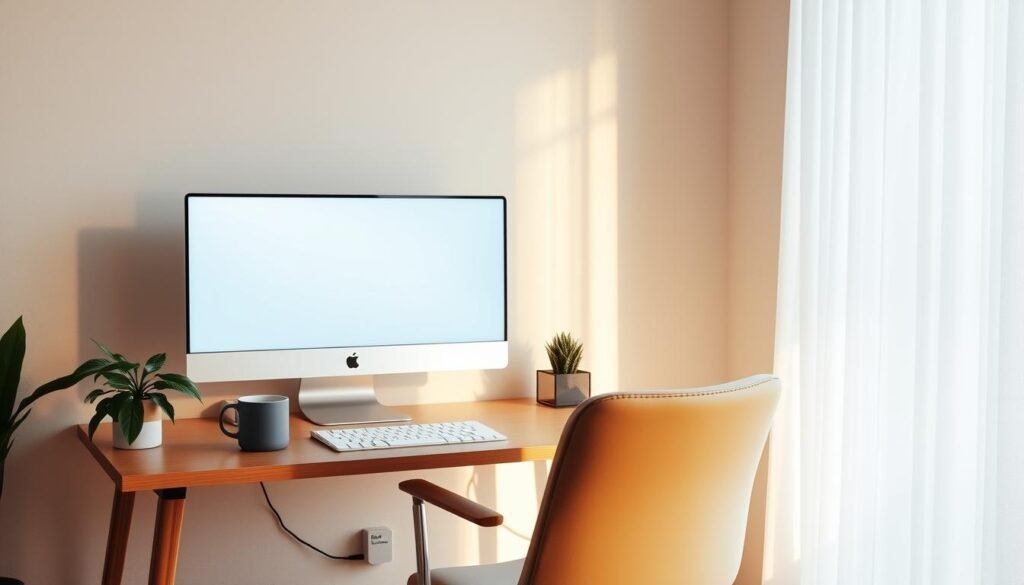Does your phone feel like a constant source of distraction rather than a tool for productivity? Many of us struggle with the overwhelming clutter on our devices, which can lead to mental fatigue and reduced focus. The good news? There’s a way to reclaim your attention and create a calmer home screen.
Inspired by Cal Newport’s philosophy, digital minimalism offers a practical approach to intentional tech use. By simplifying your phone setup, you can reduce distractions and improve your mental wellness. This isn’t about temporary fixes—it’s about creating a sustainable relationship with technology.
In this guide, we’ll walk you through a 10-step system to achieve a minimalist phone setup. These actionable steps, combined with a philosophical framework, have helped professionals like Matt Pikunic regain focus and peace. Ready to transform your digital environment? Let’s get started.
Key Takeaways
- Simplify your home screen to reduce distractions and improve focus.
- Digital minimalism promotes intentional tech use for mental wellness.
- Cal Newport’s philosophy provides a strong foundation for this approach.
- A minimalist phone setup can lead to long-term, sustainable benefits.
- Follow actionable steps to create a calmer and more productive digital environment.
What is Digital Minimalism?
Technology is everywhere, but are we using it in ways that truly add value to our lives? This question lies at the heart of digital minimalism, a philosophy introduced by Cal Newport. It focuses on spending online time on carefully selected activities that support your core values. Unlike a digital detox, which simply removes technology, this approach emphasizes intentional reconstruction.
At its core, digital minimalism contrasts with maximalist tech adoption. While maximalism encourages using every available tool, minimalism asks: “What is the cost of this technology in my life?” This echoes Thoreau’s idea of evaluating the true cost of things. In a digital context, it means assessing whether an app or platform enhances your life or drains it.
This philosophy is built on three principles: life optimization, intentionality, and value assessment. It’s not about rejecting technology entirely but about using it in ways that align with your goals. Newport critiques the “any potential benefit” justification, arguing that just because something might be useful doesn’t mean it’s worth your time.
For example, consider Netflix. A minimalist approach might involve only watching shows with others, turning it into a shared experience rather than a solo habit. A business professional case study highlights how this approach can reduce distractions and improve focus, leading to better work-life balance.
One common misconception is that digital minimalism means cutting out all technology. Instead, it’s a personalized system that encourages thoughtful choices. It also introduces the concept of “high-quality leisure” alternatives, such as reading, hobbies, or spending time with loved ones, as replacements for mindless scrolling.
By adopting this approach, we can build a healthier relationship with technology, one that supports our well-being and enhances our life rather than detracting from it.
Why Digital Minimalism Matters
In today’s fast-paced world, our attention is constantly pulled in multiple directions. With 54% of Americans feeling overwhelmed by digital clutter, it’s clear that our relationship with tech needs reevaluation. Digital minimalism isn’t just a trend—it’s a necessary skill for preserving mental health in the modern age.
Constant connectivity comes with cognitive costs. Our brains aren’t designed to handle endless notifications and interruptions. This leads to what experts call “solitude deprivation,” a state where we’re rarely alone with our thoughts. Studies show this correlates with increased anxiety and stress.
Social media platforms, like Facebook, are designed to exploit our need for validation. Sean Parker, one of Facebook’s early executives, described it as a “social-validation feedback loop.” This intermittent reinforcement keeps us hooked, but it also impacts our neurological health, making us crave likes and comments.
Generational impacts are also concerning. Digital natives, who’ve grown up with smartphones, show stunted empathy development. This is partly due to reduced face-to-face interactions. Additionally, workplace productivity suffers, with an estimated $588B annual loss in the U.S. alone.
Matt Pikunic, a professional who embraced digital minimalism, reduced his phone use by 3 hours daily. This shift allowed him to reclaim his focus and improve his mental well-being. His experience highlights the transformative power of intentional tech use.
Behavioral addiction, a concept introduced by Tristan Harris, explains why breaking free from tech is so hard. Our devices are designed to keep us engaged, often at the expense of our mental health. Digital minimalism offers a way to counter this by encouraging mindful consumption.
In a world where attention spans have shrunk over the years, adopting digital minimalism is more than a choice—it’s a necessity. By simplifying our tech use, we can protect our mental health, improve focus, and create a more balanced life.
The Impact of Social Media on Mental Wellness
Social media has become a double-edged sword in our daily lives. While it connects us, it also shapes our mental health in ways we might not realize. Platforms like Instagram and Facebook are designed to keep us engaged, often at the cost of our well-being.
One key issue is the dopamine-driven design of these platforms. Every like, comment, or notification triggers a reward response in our brains. This creates a cycle of dependency, where we crave validation through our screens. Over time, this can lead to anxiety and a sense of emptiness.
Another concern is “comparison culture.” Scrolling through curated feeds, we often compare our real lives to others’ highlight reels. This can erode self-esteem, especially among teens. Studies show a direct link between Instagram use and rising depression rates in young people.
Platforms also play a role in harmful content distribution. A New York Times report exposed how Messenger platforms have been used for child exploitation. This raises questions about the ethical responsibilities of these companies.
Cal Newport highlights the “connection vs. conversation” dichotomy. While social media connects us, it often replaces meaningful conversations with superficial interactions. This can lead to a sense of isolation, even when we’re constantly online.
Many of us have experienced the realization of spending “low-quality time” on these platforms. Instead of enriching our life, we often feel drained. Information overload and decision fatigue further compound this issue.
So, what can we do? Alternatives like “supercharged socializing” activities—such as group hikes or game nights—can foster deeper connections. By being intentional with our time, we can reclaim our mental wellness and build healthier relationships with media.
Step 1: Perform a Digital Audit
Ever feel like your device is running your life instead of the other way around? A digital audit is the first step to regaining control. It’s about understanding how you use your tech and identifying what’s truly essential. Let’s break it down into three key areas.
Track Your Screen Time
Start by monitoring how much time you spend on your phone each day. Built-in tools like iOS Screen Time or Android Digital Wellbeing can help. These features provide insights into your usage patterns, showing which apps consume the most of your day.
For example, you might discover you’re spending three hours daily on social media. This awareness is the first step toward making intentional changes. Tracking also helps you notice physical reactions, like eye strain or neck tension, that signal overuse.
Identify Unused Apps
Next, review your apps. On average, 46% of apps on a device go unused. Ask yourself: “Do I really need this app?” Avoid the “just in case” mentality. If you haven’t used an app in months, it’s likely not adding value to your life.
Consider deleting or archiving unused apps. This not only declutters your phone but also frees up storage space. A case study showed one user reduced their apps from 100 to 25, reclaiming hours of their week.
Assess Your Email Subscriptions
Finally, evaluate your email accounts. Unsubscribe from newsletters you no longer read. Use a template to categorize emails as essential or non-essential. This simple step can drastically reduce inbox clutter.
One professional, Matt, reduced his email load by 75% through unsubscribes. Pair this with a password manager audit to identify dormant accounts. By streamlining your subscriptions, you’ll save time and reduce stress.
Set metrics for success. Track your baseline measurements and aim for gradual improvement. A weekend audit can set the stage for a calmer, more intentional tech experience.
Step 2: Define Your Digital Purpose
Have you ever stopped to think about why you use certain apps or tools? Defining your digital purpose is about aligning your tech habits with your personal and professional goals. It’s not just about cutting back—it’s about making intentional choices that add value to your digital life.
Start with a “Technology Value Alignment” exercise. Ask yourself: “Does this app or tool support my goals?” For example, a writer might prioritize manuscript tools over social apps. This approach helps you focus on what truly matters.

Consider the financial costs of unnecessary subscriptions. Many of us pay for services we rarely use. Review your subscriptions and cancel those that don’t align with your purpose. This simple step can save you money and reduce clutter.
Think about your long-term goals. What kind of digital legacy do you want to leave? Planning for the future helps you make better decisions today. For instance, prioritize tools that enhance your skills or strengthen family connections.
Address common rationalizations, like the “networking potential” myth. While some apps claim to boost your career, they often waste your time. Focus on tools that deliver real value instead of empty promises.
To make this process easier, use a value assessment worksheet template. This tool helps you evaluate each app or service based on its contribution to your goals. By defining your purpose, you can create a more intentional and fulfilling tech experience.
Step 3: Declutter Your Devices
Decluttering your devices can feel overwhelming, but it’s a game-changer for focus. A clean and organized setup helps you use your tech more intentionally. Let’s break this process into manageable steps.
Remove Unused Apps
Start by evaluating your apps. If you haven’t used an app in over 30 days, it’s likely not essential. Duplicates, like multiple weather apps, can also go. One user reduced their apps from 100 to 25, reclaiming hours of their week.
Consider an “app funeral” ritual. This emotional detachment exercise helps you let go of apps you’ve outgrown. It’s a small but powerful step toward a simpler device.
Organize Your Home Screen
Your home screen should reflect your priorities. Keep only the apps you use daily. Use color psychology to arrange icons—calm colors for productivity, vibrant ones for creativity.
iOS and Android both offer tools to optimize your screen. For example, iOS lets you hide pages, while Android allows custom widgets. A clean layout reduces distractions and boosts efficiency.
Simplify Your App Folders
Folders should be intuitive and purposeful. Avoid the “miscellaneous” trap. Instead, group apps by function—Finance, Health, Learning. This makes it easier to find what you need.
Don’t forget emergency access. Keep medical apps in a visible, easy-to-reach folder. Reassess your setup quarterly to ensure it still serves your needs.
By decluttering your device, you’ll create a more intentional and productive tech experience. It’s a small change with big rewards.
Step 4: Tame Your Inbox
Managing your inbox can feel like a never-ending task, but it doesn’t have to be. With a few strategic steps, you can reduce clutter, save time, and lower anxiety. Let’s explore how to take control of your email and achieve a calmer digital experience.
Unsubscribe from Newsletters
Start by decluttering your inbox. Use tools like Unroll.me to bulk unsubscribe from newsletters you no longer read. This simple step can save hours each week. One user reclaimed 40 hours a month by streamlining their email accounts.
Set Email Check Times
Constantly checking emails can disrupt your focus. Instead, set time blocks for email management. For example, check your inbox only twice a day—once in the morning and once in the afternoon. This habit reduces distractions and boosts productivity.
Achieve Inbox Zero
Inbox zero isn’t just a myth—it’s achievable with the right system. Use the “4D System”: Delete, Delegate, Defer, or Do. This method helps you process emails efficiently. A case study showed one professional achieved inbox zero after five years of consistent effort.
To maintain an empty inbox, create a “sender blacklist” criteria and use filters to organize incoming emails. Establish “email office hours” for teams to avoid constant interruptions. For emergencies, set clear protocols to ensure important messages aren’t missed.
By taming your inbox, you’ll reclaim valuable time and reduce stress. A streamlined email system not only improves efficiency but also supports your mental wellness. Start today and experience the benefits of a calmer digital life.
Step 5: Streamline Your Digital Workflow
Streamlining your digital workflow can save you hours each week while boosting productivity. By organizing your tools and automating repetitive tasks, you’ll free up valuable time for more important things. Let’s explore how to make this happen.
Start by consolidating your apps. Use one tool for notes, tasks, and calendars instead of multiple apps. This approach reduces clutter and simplifies your workflow. For example, tools like Notion or Todoist can handle multiple functions in one place.
Automation is another game-changer. Tools like IFTTT or Zapier can handle repetitive tasks, such as saving email attachments to cloud storage. One user saved 10 hours a week by automating their workflow. It’s a small change with big rewards.
Organize your cloud storage with a clear framework. Use folders labeled by project or category and stick to a “single source of truth” for documents. This ensures you always know where to find what you need.
Regularly audit your workflow to avoid over-engineering. Quarterly reviews help you identify inefficiencies and make adjustments. Keep it simple and focused on what truly matters.
By streamlining your digital workflow, you’ll create a more efficient and stress-free experience. Start small, stay consistent, and enjoy the benefits of a well-organized system.
Step 6: Implement Digital Boundaries
Creating boundaries with technology can transform how we interact with our devices. By setting clear limits, we can reduce distractions, improve focus, and reclaim our time. This step is about designing a system that works for you and your home environment.
Create Tech-Free Zones
Start by designating specific areas in your home as tech-free zones. For example, keep devices out of the bedroom to improve sleep quality. Studies show that removing screens from sleeping areas can lead to a 23% improvement in rest. Use a “phone jail” or kitchen safe alternative to enforce these boundaries.
Set Social Media Check Times
Instead of constantly scrolling, set time blocks for social media. Tools like Focus Mode on iOS or Android can help you stick to these limits. Gradually reduce your daily usage by 15-minute increments. This approach helps you reclaim hours for more meaningful activities.
Establish a Digital Curfew
A digital curfew can protect your circadian rhythm by reducing blue light exposure before bed. Aim to turn off devices at least one hour before sleep. Family digital agreement templates can help everyone stay accountable. Over days, this habit can significantly improve your overall well-being.
By implementing these boundaries, you’ll create a healthier relationship with technology. Start small, stay consistent, and enjoy the benefits of a more balanced digital life.
Step 7: Practice Mindful Consumption
How often do you pause to question why you’re reaching for your phone? Mindful consumption is about being intentional with your attention and understanding the impact of your choices. It’s not just about cutting back—it’s about making every interaction meaningful.
Start with the “Intentional Access Protocol.” Before picking up your device, ask yourself: “Why am I opening this app?” This simple question helps you break the autopilot habit. It’s a small step that can lead to big changes in how you engage with media.

Next, configure app timers to limit usage. Tools like iOS Screen Time or Android Digital Wellbeing let you set daily limits for specific apps. Gradually reduce your time on platforms that don’t add value to your world.
Plan your information diet by curating high-quality sources. Focus on content that educates, inspires, or connects you with others. Avoid mindless scrolling by adopting the “content triage” system: Consume, Curate, Create. This approach ensures you’re intentional about what you take in and share.
One case study showed a 60% reduction in doomscrolling by implementing these strategies. The participant reclaimed hours each week, using that time for hobbies and personal growth. You can achieve similar results with consistent effort.
Digital mindfulness meditation can also help. Spend a few minutes daily focusing on your breath while reflecting on your tech habits. This practice builds awareness and reduces stress.
Be wary of multitasking myths. Research shows it reduces productivity and increases errors. Instead, focus on one task at a time to improve efficiency and mental clarity.
Redesign your physical environment to support mindful consumption. Create charging stations outside bedrooms to reduce late-night screen time. This small change can improve sleep quality and overall well-being.
Establish a notification hierarchy system. Prioritize alerts from essential apps and mute non-urgent ones. This reduces distractions and helps you stay focused on what matters.
Finally, journal weekly to reflect on your content consumption. Note what you’ve learned and how it aligns with your goals. This habit reinforces intentionality and helps you stay on track.
By practicing mindful consumption, you’ll transform your relationship with technology. It’s a journey toward greater focus, clarity, and balance in your things.
Step 8: Create a Minimalistic Phone
Your phone doesn’t have to be a source of chaos—it can be a tool for calm. A cluttered home screen and endless notifications can overwhelm your mind. By simplifying your setup, you can reduce distractions and reclaim your focus. Let’s explore how to create a minimalist phone that supports your goals.
Simplify Your Wallpaper
Start with your wallpaper. A busy background can make your screen feel chaotic. Choose a simple, calming image or a solid color. Studies show that neutral tones reduce visual stress and improve focus. This small change can make a big difference in how you interact with your device.
Remove Apps from the Home Screen
Next, declutter your home screen. Keep only the apps you use daily. Hide or move less frequently used apps to a secondary screen or folder. This creates “app retrieval friction,” making you think twice before opening unnecessary apps. One case study showed a 53% reduction in Instagram usage after this change.
Use Grayscale Mode
Consider switching to grayscale mode. This removes the vibrant colors that often draw us in. Digital Wellbeing studies show that monochrome screens reduce the urge to check your phone. It’s a simple trick that can help you break the habit of mindless scrolling.
Be mindful of hidden distractions like widgets. While they can be useful, they often pull your attention away. Opt for a clean, organized layout. You can also enhance your phone’s tactile experience with a textured case, adding a physical reminder to use it intentionally.
Finally, customize your lock screen with a mantra or reminder. This small touch can help you stay focused on your priorities. By creating a minimalist phone, you’ll transform it from a source of distraction to a tool for clarity in your world.
Step 9: Develop Digital Detox Habits
Taking a break from screens can feel daunting, but the benefits are worth it. Developing detox habits helps us reset our relationship with technology and reclaim our focus. Let’s explore practical ways to unplug and recharge.
Schedule Offline Days
Start by designating specific days to disconnect. “Offline Saturdays” have proven successful for many, offering a full day to focus on hobbies, family, or self-care. Use a quarterly detox planning template to stay consistent and track your progress.
Take Regular Digital Breaks
Short breaks throughout the week can make a big difference. Try the Forest app, which gamifies staying off your phone by growing virtual trees. Micro-detox strategies, like phone-free meals, also help build healthier habits over time.
Leave Your Phone Behind
Sometimes, the best way to detox is to leave phone at home. Plan “analog adventures,” like hikes or creative projects, to reconnect with the physical world. One case study showed completing four creative projects during a detox weekend.
Be mindful of withdrawal symptoms, like restlessness or anxiety. A buddy system can provide accountability and support. Rediscover hobbies or explore new ones to fill the void left by reduced screen time.
Attention restoration theory shows that time in nature or engaging in creative activities can refresh your mind. Start small, stay consistent, and enjoy the benefits of a balanced digital life.
Step 10: Monitor and Adjust Regularly
Maintaining a balanced relationship with technology requires ongoing effort. It’s not a one-time fix but a continuous process of refinement. By regularly reviewing your habits, you can ensure they stay aligned with your goals and values.
Start with weekly screen time reviews. Tools like iOS Screen Time or Android Digital Wellbeing provide insights into your usage. Use a maintenance calendar template to track changes and identify patterns over time.
Adaptive boundary adjustments are crucial. As your digital life evolves, so should your limits. For example, if you notice increased app usage, revisit your boundaries and tighten them. Flexibility ensures your system remains effective.
Annual digital philosophy updates help you stay intentional. Reflect on your goals and assess whether your tech habits still support them. This yearly check-in prevents complacency and keeps you focused on what truly matters.
Introduce a “tech replacement” evaluation criteria. Before adding a new app or tool, ask: “Does this replace something less effective?” This approach ensures your setup stays streamlined and purposeful.
Consider the 18-month refinement process of one case study. Over years, the participant gradually reduced distractions and improved focus. Their journey highlights the power of consistent adjustments.
Progress tracking metrics are essential. Measure your screen time, app usage, and productivity levels. Use these insights to make informed decisions and celebrate small wins.
Community accountability options can boost your efforts. Share your goals with friends or join a group focused on intentional tech use. Peer support keeps you motivated and accountable.
For deeper guidance, consider professional digital coaching. Experts can help you design a personalized system and address challenges. Their insights can accelerate your progress.
Finally, reference continuous improvement models. Small, consistent changes lead to lasting results. By monitoring and adjusting regularly, you’ll create a healthier, more intentional relationship with technology.
The Benefits of Digital Minimalism
Simplifying your digital habits leads to tangible improvements in focus and well-being. By adopting a more intentional approach to technology, we can transform our daily life and reclaim our attention. Studies show that reducing digital clutter can lower stress by up to 57%, offering a calmer and more productive world.
One of the most significant benefits is financial savings. Cutting unused subscriptions can save hundreds of dollars annually. For example, one user reduced their monthly expenses by $50 simply by canceling services they no longer needed.
Relationship quality also improves with digital minimalism. By setting boundaries with technology, we can focus more on meaningful interactions. A longitudinal study found that couples who practiced mindful tech use reported stronger connections and better communication.
Corporate adoption of this approach is growing. Companies like Basecamp have implemented policies to reduce digital distractions, leading to higher employee satisfaction and productivity. These case studies highlight the professional advantages of intentional tech use.
Time reclamation is another key benefit. On average, individuals save 3 hours daily by streamlining their digital habits. This extra time can be spent on hobbies, family, or personal growth, enhancing overall well-being.
Physical health also sees improvements. Reduced screen time can alleviate eye strain and improve posture. One participant reported less neck pain after adopting a minimalist phone setup.
Creative output increases as well. With fewer distractions, individuals can focus on projects and ideas. A study showed a 40% boost in creative productivity among those who practiced digital minimalism.
Finally, this approach supports long-term digital legacy planning. By being intentional with our tech use, we can create a healthier relationship with technology that benefits future generations.
In the professional sphere, digital minimalism is becoming a career advancement strategy. Employers value employees who can manage their time and focus effectively, making this skill a key asset in today’s workplace.
Conclusion: Embrace a Calmer Digital Life
Transforming your relationship with technology starts with small, intentional steps. By embracing a calmer approach, you can reclaim your time and focus on what truly matters in your life. This isn’t about perfection—it’s about progress.
Start with one step today. Whether it’s decluttering your phone or setting boundaries, each action builds toward a more intentional world. Remember, this is a journey, not a race. Celebrate small wins and adjust as needed.
You’re not alone in this. Many have found success by gradually implementing these changes. Resources and communities are available to support you along the way. Your attention is your most valuable asset—use it wisely.
Take the first step now. Download our action plan and begin your journey toward a calmer, more focused digital experience. The power to transform your relationship with technology is in your hands.
FAQ
What is Digital Minimalism?
It’s a mindful approach to using technology, focusing on tools that add value while reducing unnecessary distractions. It helps create a healthier relationship with your devices.
Why does Digital Minimalism matter?
It reduces stress, improves focus, and frees up time for meaningful activities. By cutting out digital clutter, you can prioritize what truly matters in your life.
How does social media affect mental wellness?
Excessive use can lead to anxiety, loneliness, and reduced productivity. Setting boundaries helps maintain a healthier balance.
How do I perform a digital audit?
Track your screen time, identify unused apps, and assess email subscriptions. This helps you understand where your time goes and what to cut.
How do I define my digital purpose?
Decide which apps and tools align with your goals. Focus on those that enhance your life and eliminate the rest.
What’s the best way to declutter my devices?
Remove unused apps, organize your home screen, and simplify app folders. This creates a cleaner, more efficient digital space.
How can I tame my inbox?
Unsubscribe from newsletters, set specific times to check emails, and aim for inbox zero. This reduces overwhelm and improves focus.
What are digital boundaries?
These are rules like tech-free zones, scheduled social media checks, and a digital curfew. They help you disconnect and recharge.
How do I practice mindful consumption?
Be intentional about what you consume online. Focus on content that adds value and avoid mindless scrolling.
How can I create a minimalistic phone?
Simplify your wallpaper, remove apps from the home screen, and use grayscale mode. These steps reduce visual clutter and distractions.
What are digital detox habits?
Schedule offline days, take regular breaks, and leave your phone behind during certain activities. These habits help you reconnect with the real world.
How often should I monitor my digital habits?
Regularly assess your usage and adjust as needed. This ensures you stay aligned with your goals and maintain a healthy balance.
What are the benefits of Digital Minimalism?
It improves mental clarity, reduces stress, and frees up time for meaningful connections and activities. It’s a path to a calmer, more intentional life.




